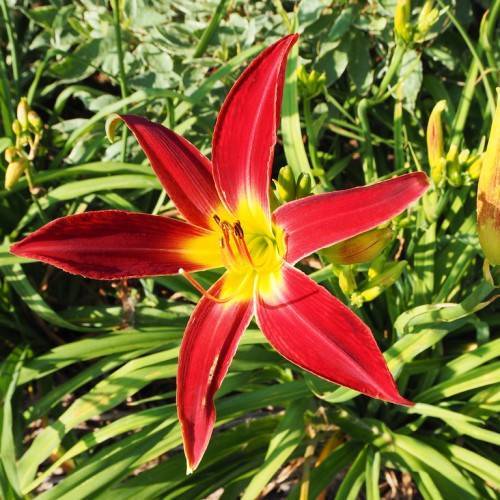
daylily
Hemerocallis 'Fly Catcher'
Cycle:
Herbaceous Perennial
Watering:
Average
Hardiness Zone:
3 - 9
Flowers:
Flowers
Sun:
Full sun,part shade
Leaf:
Yes
Growth Rate:
Low
Maintenance:
Low
Drought Tolerant:
Yes
Salt Tolerant:
Yes
watering
The daylily (Hemerocallis 'Fly Catcher') adapts well to many soil types but prefers moist yet well-draining soil conditions. It thrives in slightly acidic soils or soils with a pH around 6. For best results, water regularly, giving the plant 1–2 inches of water per week or the equivalent in rainfall. Water deeply, allowing the water to saturate the soil 8–10 inches deep, approximately once per week. Water more often during exceptionally hot weather. Avoid overwatering as this can lead to root rot and fungal disease.
sunlight
Daylily (Hemerocallis 'Fly Catcher') plants need at least 6-8 hours of direct sunlight every day to thrive. Morning sun is best, as it helps to give them an even mix of light and warmth, though they can handle some afternoon sun as well. They are hardy and can thrive even in places with intense summer sunlight. For optimal growth, daylilies should be placed in a spot that receives full sun for the better part of the day. In the summer months, the plants can get extra boost from extended sunshine, but during more extreme hot times of the year, it's best to limit their exposure to afternoon sun from 3 pm onwards, as this can be too intense. In winter, direct sun exposure will help keep daylilies blooming, especially for longer periods.
pruning
Daylilies should be pruned in early spring, just before new growth begins. The plants should be cut back to just a few inches above ground level. Old flower stalks should be removed as well. After pruning, the area should be mulched to help retain moisture. If the daylily foliage gets too long, it can be lightly pruned in mid-summer to encourage more blooms. Dead or diseased foliage should also be removed as soon as possible.
